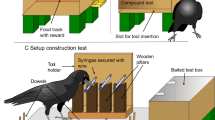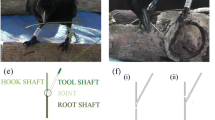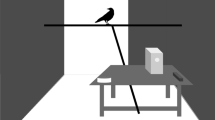Abstract
New Caledonian crows Corvus moneduloides (NC crows) display sophisticated tool manufacture in the wild, but the cognitive strategy underlying these skills is poorly understood. Here, we investigate what strategy two free-living NC crows used in response to a tool-length task. The crows manufactured tools to extract food from vertical holes of different depths. The first tools they made in visits were of a similar length regardless of the hole depth. The typical length was usually too short to extract food from the deep holes, which ruled out a strategy of immediate causal inference on the first attempt in a trial. When the first tool failed, the crows made second tools significantly longer than the unsuccessful first tools. There was no evidence that the crows made the lengths of first tools to directly match hole depth. We argue that NC crows may generally use a two-stage heuristic strategy to solve tool problems and that performance on the first attempt in a trial is not necessarily the ‘gold standard’ for assessing folk physics.






Similar content being viewed by others
References
Betsch T, Haberstroha S, Molterb B, Glöcknerc A (2004) Oops, I did it again–relapse errors in routinized decision making. Organ Behav Hum Decision Process 93:62–74
Chappell J, Kacelnik A (2002) Tool selectivity in a non-primate, the New Caledonian crow (Corvus moneduloides). Anim Cogn 5:71–78
Chappell J, Kacelnik A (2004) Selection of tool diameter by New Caledonian crows Corvus moneduloides. Anim Cogn 7:121–127
Emery NJ (2006) Cognitive ornithology: the evolution of avian intelligence. Phil Trans R Soc B 361:23–43
Evans TA, Westergaard GC (2004) Discrimination of functionally appropriate and inappropriate throwing tools by captive tufted capuchins (Cebus apella). Anim Cogn 7:255–262
Fujita K, Kuroshima H, Asai S (2003) How do tufted capuchin monkeys (Cebus apella) understand causality involved in tool use? J Exp Psychol Anim Behav Process 29:233–242
Hauser MD (1997) Artifactual kinds and functional design features: what a primate understands without language. Cogn 64:285–308
Hauser MD, Pearson H, Seelig D (2002) Ontogeny of cotton-top tamarins, Saguinus oedipus: innate recognition of functionally relevant features. Anim Behav 64:299–311
Hunt GR (1996) Manufacture and use of hook-tools by New Caledonian crows. Nature 379:249–251
Hunt GR (2000a) Human-like, population-level specialization in the manufacture of pandanus tools by New Caledonian crows Corvus moneduloides. Proc R Soc Lond B 267:403–413
Hunt GR (2000b) Tool use by the New Caledonian crow Corvus moneduloides to obtain Cerambycidae from dead wood. Emu 100:109–114
Hunt GR, Gray RD (2002) Species-wide manufacture of stick-type tools by New Caledonian crows. Emu 102:349–353
Hunt GR, Gray RD (2003) Diversification and cumulative evolution in New Caledonian crow tool manufacture. Proc R Soc Lond B 270:867–874
Hunt GR, Gray RD (2004a) The crafting of hook tools by wild New Caledonian crows. Proc R Soc Lond B (Suppl) 271:S88–S90
Hunt GR, Gray RD (2004b) Direct observations of pandanus-tool manufacture and use by a New Caledonian crow (Corvus moneduloides). Anim Cogn 7:114–120
Kral K (2003) Behavioural-analytical studies of the role of head movements in depth perception in insects, birds and mammals. Behav Process 64:1–12
Martin GR, Coetzee HC (2004) Visual fields in hornbills: precision-grasping and sunshades. Ibis 146:18–26
Martin GR, Katzir G (1999a) Visual fields in short-toed eagles, Circaetus gallicus (Accipitridae), and the function of binocularity in birds. Brain Behav Evol 53:55–66
Martin GR, Katzir G (1999b) Visual fields, foraging and binocularity in birds. In: Adams NJ, Slotow RH (eds) Proceedings of the 22nd international ornithological congress. BirdLife South Africa, pp 2711–2728
McGrew WC (1992) Chimpanzee material culture: implications for human evolution. Cambridge University Press, Cambridge, UK
Millikan GC, Bowman RI (1967) Observations on Galápagos tool-using finches in captivity. Living Bird 6:23–41
Nagel K, Olguin RS, Tomasello M (1993) Processes of social learning in the tool use of chimpanzees (Pan troglodytes) and human children (Homo sapiens). J Comp Psychol 107:174–186
Povinelli DJ (2000) Folk physics for apes: the chimpanzee's theory of how the world works. Oxford University Press, Oxford
Rutledge R, Hunt GR (2004) Lateralized tool use in wild New Caledonian crows. Anim Behav 67:327–332
Silva FJ, Page DM, Silva KM (2005) Methodological–conceptual problems in the study of chimpanzees’ folk physics: how studies with adult humans can help. Learn Behav 33:47–58
Sterelny K (2003) Thought in a hostile world: the evolution of human cognition. Blackwell, Oxford
Tebbich S, Bshary R (2004) Cognitive abilities related to tool use in the woodpecker finch, Cactospiza pallida. Anim Behav 67:689–697
Thouless CR, Fanshawe JH, Bertram CR (1987) Egyptian vultures Neophron percnopterus and Ostrich Struthio camelus eggs: the origins of stone-throwing behaviour. Ibis 131:9–15
Tomasello M (1999) The cultural origins of human cognition. Harvard University Press, Cambridge, MA
Tomasello M, Call J (1997) Primate cognition. Oxford University Press, New York
Visalberghi E, Limongelli L (1996) Acting and understanding: tool use revisited through the minds of capuchin monkeys. In: Russon AE, Bard KA, Parker ST (eds) Reaching into thought: the minds of the great apes. Cambridge University Press, Cambridge, UK, pp 57–79
Watanabe S, Huber L (2006) Animal logics: decisions in the absence of human language. Anim Cogn DOI: 10.1007/s10071-006-0043-6
Weir AAS, Kacelnik A (2006) New Caledonian crows (Corvus moneduloides) creatively re-design tools by bending or unbending metal strips according to needs. Anim Cogn DOI: 10.1007/s10071-006-0052-5
Weir AAS, Chappell J, Kacelnik A (2002) Shaping of hooks in New Caledonian crows. Science 297:981
Weir AAS, Kenward B, Chappell J, Kacelnik A (2004) Lateralization of tool use in New Caledonian crows (Corvus moneduloides). Proc R Soc Lond B (Suppl) 271:S344–S346
Whiten A, Goodall J, McGrew WC, Nishida T, Reynolds V, Sugiyama Y, Tutin CEG, Wrangham RW, Boesch C (1999) Cultures in chimpanzees. Nature 399:682–685
Acknowledgements
We thank Emile Hautcoeur for access to his land at Sarraméa. Staff in the Political Section of the provincial administration on Maré provided valuable help with access to forest and William Wadrobert kindly allowed us to work on his family's land in Wabao District. Daniel Houmbouy (Province des Iles Loyauté) gave us permission to work on Maré, and Etienne DuTailly provided us with accommodation and assistance in Nouméa. We thank Mick Sibley for preparing DVD versions of the footage and Michael Corballis and Alex Taylor for helpful comments on the manuscript. This research was funded by an Auckland University Emerging Researchers Grant (G.R.H.), the New Zealand Marsden Fund (R.D.G. and G.R.H.) and a Thomas J. Watson Fellowship (R.B.R.). The research reported in this paper was approved by the University of Auckland Animal Ethics committee (approval #R172). We thank Shige Watanabe and Ludwig Huber for inviting us to participate in the Animal Logic symposium in Vienna, and Alex Weir and Alex Kacelnik for an exchange of crow manuscripts submitted to this volume.
Author information
Authors and Affiliations
Corresponding author
Additional information
This contribution is part of the special issue ‘Animal Logics’ (Watanabe and Huber 2006).
Rights and permissions
About this article
Cite this article
Hunt, G., Rutledge, R. & Gray, R. The right tool for the job: what strategies do wild New Caledonian crows use?. Anim Cogn 9, 307–316 (2006). https://doi.org/10.1007/s10071-006-0047-2
Received:
Revised:
Accepted:
Published:
Issue Date:
DOI: https://doi.org/10.1007/s10071-006-0047-2




